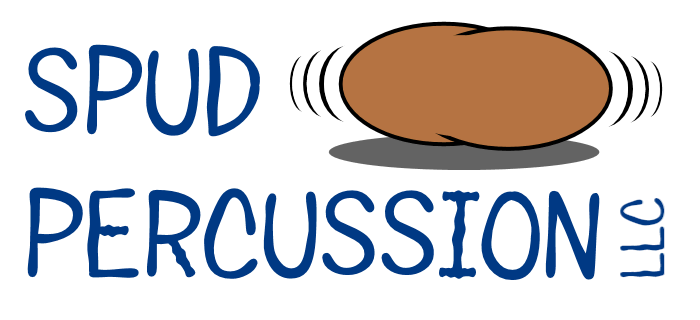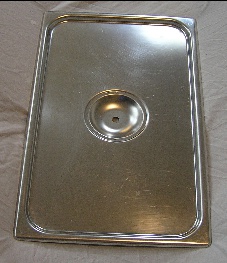
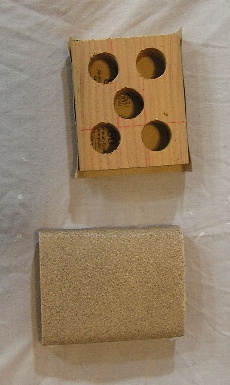
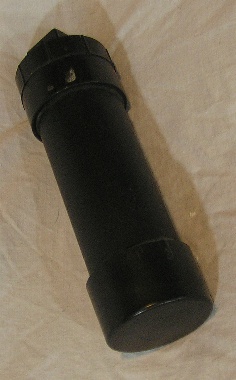

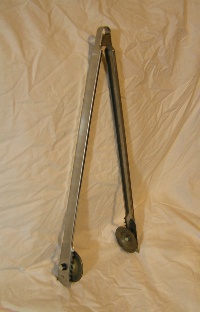
Here's a nifty little idea that's easy to do. Acquire a lid for
a rectangular stainless-steel steam table pan, about 13" x
21" (For some reason, the square and round ones don't
sound as good). These can be found at restaurant supply
stores and online. Remove the little handle thingie that goes
across the dip in the center. This can be done easily by
gently bending it back and forth with a set of vise-grip type
pliers if it's just spot-welded on, or use a Dremel tool with
a cut-off wheel if it's fastened more securely. Drill a 3/8"
hole in the center of the dome, and mount it like a china
cymbal, with the top of the lid as your striking surface.
Smack the raised rim around the edge like the rim of a
china, or ride on the flat surface. A wonderfully obnoxious
sound - like a china with the high end removed.
Ever have a call for sandpaper blocks, and you find that
the typical version just can't be heard over anything
louder than a mosquito? Here's a way to get a little more
projection.
Cut a couple of pieces of 2x4 about 4" long - try to minimize the knots. Drill 5 holes between 7/8" - 1" in diameter, evenly spaced on the diagonals as shown. Cut two pieces of sandpaper, of whatever grit is needed, about 4" x 4-1/2" - this should allow the paper to wrap around the narrow dimension of the block about 1/2" on either side. Staple the sandpaper to the blocks in that 1/2" overlap, and away you go! Hold them by the un-sanpapered ends to keep the "sound holes" free. OK, sandpaper blocks are never going to bust your eardrums, but this helps get a little more projection out of them. When the grit is gone, or you need finer or coarser grit, pry out the staples and put on new paper.
Cut a couple of pieces of 2x4 about 4" long - try to minimize the knots. Drill 5 holes between 7/8" - 1" in diameter, evenly spaced on the diagonals as shown. Cut two pieces of sandpaper, of whatever grit is needed, about 4" x 4-1/2" - this should allow the paper to wrap around the narrow dimension of the block about 1/2" on either side. Staple the sandpaper to the blocks in that 1/2" overlap, and away you go! Hold them by the un-sanpapered ends to keep the "sound holes" free. OK, sandpaper blocks are never going to bust your eardrums, but this helps get a little more projection out of them. When the grit is gone, or you need finer or coarser grit, pry out the staples and put on new paper.
If you want to make some great shakers, all you need is
a length of ABS pipe, some pipe caps, pipe cement and
some plastic BBs. ABS is typically available between
1-1/2, 2, 3, 4 & 6 inch pipe sizes, and the 1-1/2" & 2"
are generally best for one-handed use. Cut a piece of
pipe 6-8" long, glue a cap on one end, let the glue set
(waiting - always the hardest part!), add some BBs, and
put (don't glue) a cap on the other end. Shake it, and
add or remove BBs until you get the sound you like.
When you do, glue the other cap on and you're ready to
go. As an alternative, you can use a threaded
"clean-out" fitting on one end if you want the option to
be able to change the contents.
If ABS pipe is unavailable where you live, drop me a note at questions@spudpercussion.com and we'll see if we can fix you up.)
If ABS pipe is unavailable where you live, drop me a note at questions@spudpercussion.com and we'll see if we can fix you up.)
If you have an idea you'd like to post, send me a note at
ideas@spudpercussion.com.
Two of my favorite places for drum-building supplies:
American Drum Parts - www.amdrumparts.com/
DrumMaker.com - www.drummaker.com/
Two of my favorite places for drum-building supplies:
American Drum Parts - www.amdrumparts.com/
DrumMaker.com - www.drummaker.com/
If you are looking for the sound of claves, but don't happen to have a pair handy, head
to your local pet store. A couple of beef bones about 6" long will make a nice sharp
clave sound. Try out pairs until you find a sound that works. The employees will think
you're strange, but given your choice of web sites, you're probably used to that...
Make finger cymbals easier to use with a set of
spring-loaded salad tongs. Take the stretchy things out
of the finger cymbal holes. Get machine screws just
small enough to fit through the holes, o-rings or nylon
washers to fit the screws, and locknuts with nylon
inserts for the screws. You may also need nylon spacers
to put some distance between the cymbals and the metal
of the tongs. Drill holes for the screws in the business
end of the tongs and mount the cymbals, not too tightly,
as shown, using the o-rings/washers/spacers to eliminate
the metal-to-metal contact. Lastly, snip off any excess
from the screws. You can now play them one-handed on
your knee, or two-handed if you need more control.
When they're not in use, you can drape them over any
horizontal piece of your kit, lay them on a trap table, or
squeeze the halves together and slip them into a stick
bag.
